The ADATA XPG GAMMIX S10 (512GB) SSD Review: Entry-Level NVMe With Style
by Billy Tallis on October 25, 2017 8:30 AM ESTAnandTech Storage Bench - The Destroyer
The Destroyer is an extremely long test replicating the access patterns of very IO-intensive desktop usage. A detailed breakdown can be found in this article. Like real-world usage, the drives do get the occasional break that allows for some background garbage collection and flushing caches, but those idle times are limited to 25ms so that it doesn't take all week to run the test. These AnandTech Storage Bench (ATSB) tests do not involve running the actual applications that generated the workloads, so the scores are relatively insensitive to changes in CPU performance and RAM from our new testbed, but the jump to a newer version of Windows and the newer storage drivers can have an impact.
We quantify performance on this test by reporting the drive's average data throughput, the average latency of the I/O operations, and the total energy used by the drive over the course of the test.
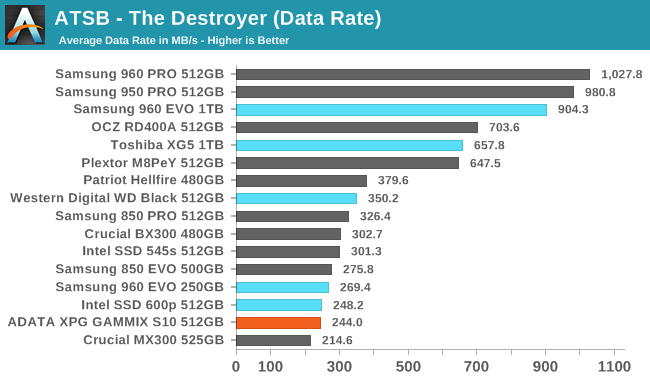
The ADATA XPG GAMMIX S10 delivers an average data rate on The Destroyer that is essentially tied with the Intel 600p. This performance falls within the range of mainstream SATA SSDs, while most other TLC-based NVMe SSDs can at least outperform SATA SSDs.
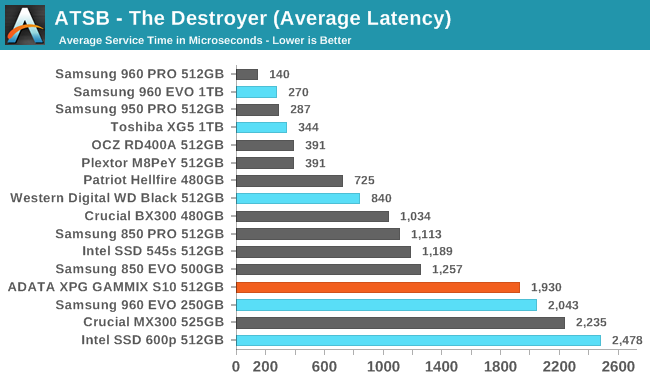
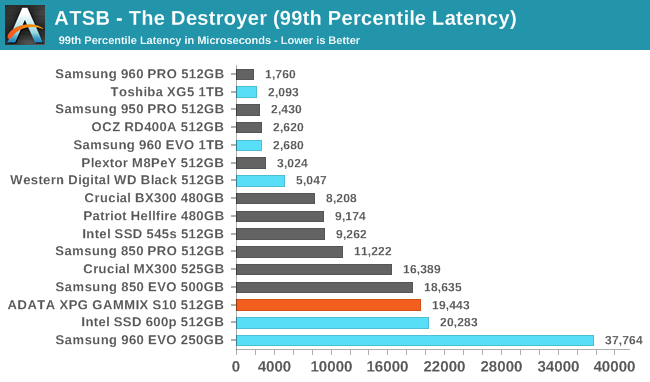
The average latency of the GAMMIX S10 on The Destroyer is substantially better than the Intel 600p, while its 99th percentile latency is only slightly improved over the 600p. On both metrics, the GAMMIX S10 still rates worse than many mainstream SATA SSDs.
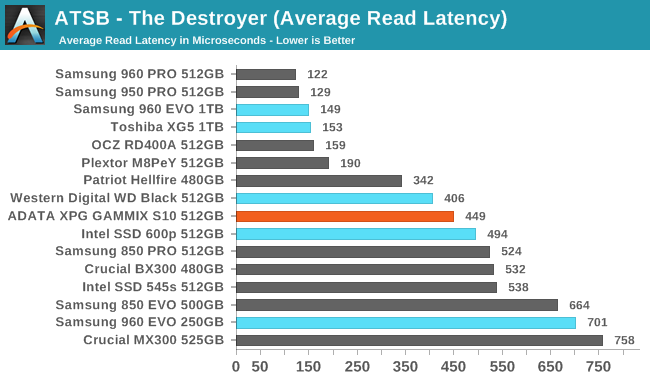
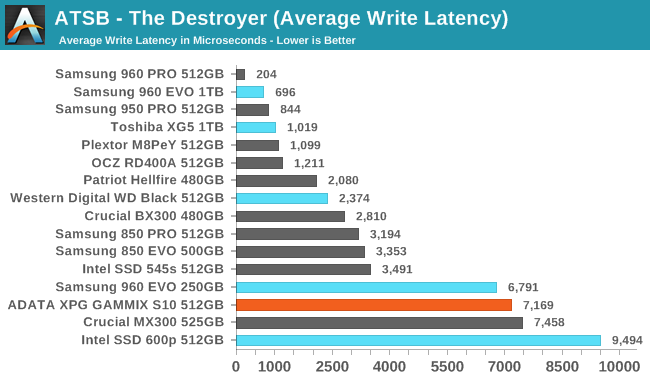
The average read latency of the GAMMIX S10 on The Destroyer is better than any SATA SSD and better than the Intel 600p. The average write latency is a significant improvement over the 600p but is otherwise still quite bad, with latency twice as high as typical mainstream SATA SSDs.
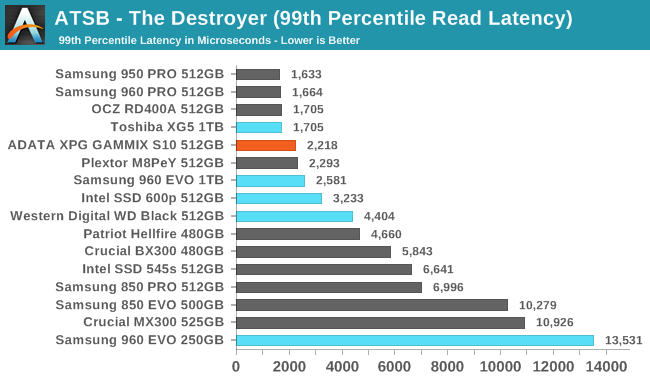
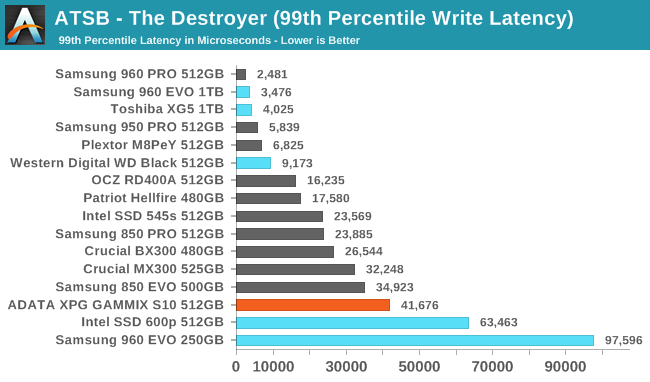
The 99th percentile read latency of the GAMMIX S10 is great, but not quite fast enough to place it in the very top tier of drives along Samsung and Toshiba. The 99th percentile write latency ranks at the other end of the field, worse than most mainstream SATA SSDs, though trailing by a less embarrassing margin than the Intel 600p.
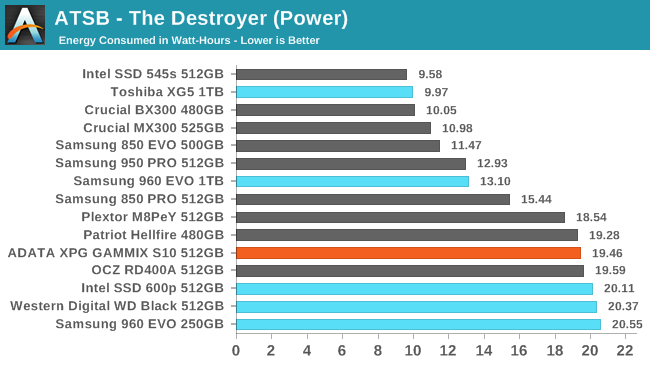
The energy usage of the ADATA XPG GAMMIX S10 on The Destroyer is typical for NVMe SSDs. It's a bit more efficient than the Intel 600p or WD Black, but still uses twice as much energy as a good SATA SSD.










27 Comments
View All Comments
futrtrubl - Wednesday, October 25, 2017 - link
Disappointing.jabber - Wednesday, October 25, 2017 - link
Why? You wouldn't notice if it could do 3500MBps either.futrtrubl - Thursday, October 26, 2017 - link
Because it does less but costs more. What isn't disappointing about that?jabber - Thursday, October 26, 2017 - link
Yeah but it looks much fancier so to the average Joe that's worth another $30! It's a strategy that Apple has used and been praised for for decades. Performance means nothing to the computing masses. It's just those of us on IT forums that care.FullmetalTitan - Thursday, October 26, 2017 - link
No "average Joe" is even looking at NVMe SSDs.This costs double the price of a GOOD SATA SSD, and frequently fails to even meet that performance level.
jabber - Thursday, October 26, 2017 - link
You'd be amazed at what I see 'Average Joe's buy. Shocking at times."Why did you buy...that?"
ddriver - Wednesday, October 25, 2017 - link
That's some pristine engineering idiocy right there, having the heatsink make contact with only a small part of the chip area deliberately.ddriver - Wednesday, October 25, 2017 - link
"GAMMIX" - more like "gimmix" LOLrrinker - Wednesday, October 25, 2017 - link
I saw that skipped right to the conclusion for the (predicted) disappointing results. If they screw up the engineering for the sake of appearance like that, I was sure the rest of it would be disappointing as well.ddriver - Wednesday, October 25, 2017 - link
The thing is that the heatsink is protruding between the adhesive pads, so it presumably makes contact with the chip, however without any thermal interface material it is likely that the heatsink severs to insulate and worsen thermal performance than to improve it.Probably it is a mix of both, yielding somewhere between barely improving to barely "detrimenting" thermal performance, making it mostly a pointless gimmick.
Like everyone else, ADATA is well aware how low average consumer IQ is, thus attempting to make this fly.
On the bright side of things, adding some thermal paste would easily make the cooling solution functional. Although I doubt the product performance will get any less pathetic because of that. They didn't put that heatsink there because it is throttling as a side-effect of being very fast. They put it as a cosmetic feature, that much is evident from the clumsy implementation.